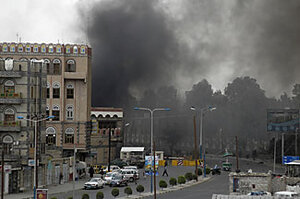U.S. Embassy hit in Yemen, raising militancy concerns
Five explosions and sniper fire struck the US compound in a coordinated attack on Wednesday.

Al Qaeda? Smoke rose from the heavily fortified US Embassy in Sanaa after a series of explosions during the attack on the compound.
Yemen News Agency/Reuters
Sanaa, Yemen
The blast shattered the silence here as the city slept through the early fasting hours of Ramadan. A suicide bomber exploded his car Wednesday morning outside the US embassy in the worst attack on the American compound in recent years. It comes at a time when Yemen is coping with an increasingly active Islamist militancy.
People who live near the embassy reported heavy exchanges of gunfire, and initial reports say that at least 16 people were killed, including six Yemeni soldiers and six attackers, though no official numbers have been released. Embassy officials say none of its staff were killed.
A little-known group calling itself Islamic Jihad in Yemen claimed responsibility and threatened similar strikes against the British, Saudi Arabian, and United Arab Emirates' missions in Yemen. Previous such attacks in Yemen have been claimed by Al Qaeda.
The intelligence consulting firm Stratfor said Wednesday, "the explosions and gunfire suggest that suicide bombers as well as gunmen were involved in what appears to have been a complex attack likely perpetrated by jihadists affiliated with the Yemeni node of Al Qaeda."
It says the attack will further aggravate growing tension between Washington and Sanaa over how Yemen has been handling the Islamist militancy in its country.
Washington considers Yemeni President Ali Abdullah Saleh an ally against terrorism, ever since Al Qaeda's 2000 bombing of the USS Cole destroyer in the port of Aden, which killed 17 American sailors. But the relationship has frequently been rocky, with American officials grumbling over lax Yemeni detention policies for militants.
A group of 23 Al Qaeda militants escaped from a high-security Sanaa prison in 2006, amid reports of collusion between security officials and the militants. Stratfor said in its statement that Yemen's security and intelligence services are deeply infiltrated by militants.
"This attack targeted Yemen and America at the same time," says Yemeni journalist Adel al-Ahmedi, standing among a crowd of hundreds who gathered at the scene. "The people who waged this attack are fed up with the government, and they target the American embassy to try to harm relations between the US and Yemen.... This is a clear tragedy, but we are afraid of America's response more than the attack itself."
Unconfirmed reports have suggested that as many as five explosions struck the embassy. Bystanders said that two cars were involved in the attack. The first car was reported to have been filled with people dressed in police uniforms, who attacked the embassy with heavy weaponry. The second car exploded in a suicide attack outside the embassy.
"What kind of animals did this?" one officer said to another, looking over a police truck riddled with bullet holes. "Who could kill innocent people like this? These people aren't Muslims."
In the distance, soldiers wrapped yellow tape around areas that were scattered with shrapnel. Hundreds of soldiers in trucks mounted with antiaircraft guns kept people blocks away from the scene of the blast.
"I have never heard anything this loud in Sanaa," taxi driver Abdullah Sharaf, who lives in a neighborhood near the embassy, says of the suicide bombing. "The blast was so strong that it blew open the doors to my house."
Yemen has been facing a multifaceted insurgency in recent years. A group that calls itself the Believing Youth had been waging an insurgency in the northern city of Saada, calling for reinstatement of Yemen's past Islamic government. The group recently signed a peace agreement with the government, though sporadic clashes continue in the north.
"The problem is that there is no democracy or economic stability in Yemen," says Mohammed al-Mutawakkal, a political science professor at Sanaa University. "If we had stability and people were satisfied with our government, we wouldn't be facing these problems."
The US embassy has been targeted before – though previous attacks have been less organized. A volley of mortars targeted the embassy in March, but instead hit a nearby girls' school. In 2006, a gunman opened fire outside the embassy.
In 2003, two people were fatally shot and dozens more were injured when police clashed with demonstrators trying to storm the embassy after tens of thousands rallied against the US-led invasion of Iraq.
• Material from the Associated Press contributed to this report.
